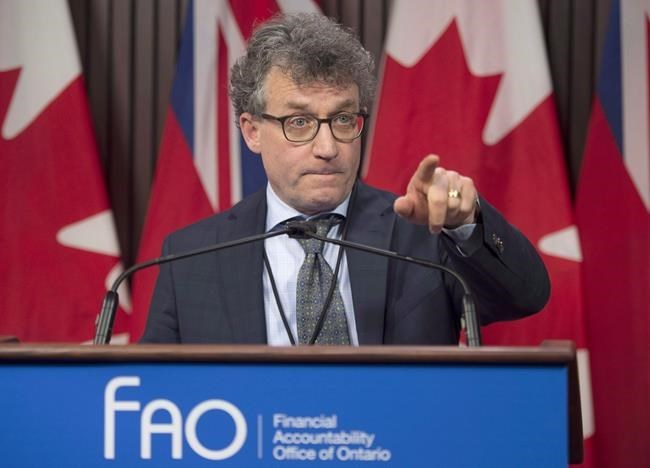TORONTO — Ontario is on track for years of post-pandemic deficits unless the government hikes taxes or cuts services, the province's fiscal watchdog said in a new report Thursday.
Financial accountability officer Peter Weltman said a series of factors, including the pandemic and aging demographics, will contribute to the deficit, which he projects will grow to $35.5 billion in 2020-21.
That figure is forecast to drop to $16 billion by 2024-25 and remain at that level moving forward, barring any government policy change, he said.
"The key takeaway here is that we're going to be pretty much stuck at a $16-billion ongoing deficit once we get through the pandemic," Weltman said.
"That's what our forecast shows unless there are significant spending or revenue changes going forward."
The FAO report focuses on Ontario's financial information up to Feb. 5 and doesn't take into account the province's latest fiscal projections released Wednesday.
In those projections, the government predicted it will finish the 2020-21 fiscal year with a record $38.5-billion deficit -- an amount larger than what the FAO projected due to the allocation of an additional $3 billion in spending.
Finance Minister Peter Bethlenfalvy acknowledged Thursday that the province's deficits were not sustainable in the long run, but disagreed with the report's assessment that service cuts or tax hikes will be required to address it.
"There is a third option – economic growth," he said in a statement. "We will choose that path and foster the conditions for Ontario’s economy to bounce back, and will have more to say in next month's budget."
By law, when Ontario is in deficit, it must develop a recovery plan that charts a path to balanced budgets. The province is expected to deliver its 2021-22 budget by March 31.
The FAO report projects Ontario's economy will take a major hit because of the pandemic, noting that gross domestic product dropped a record of nearly six per cent in 2020.
However, Weltman projects that Ontario will rebound strongly over the next two fiscal years, with GDP growth of 3.9 per cent in 2021 and 4.5 per cent in 2022.
Outside of pandemic funding projected over the next two fiscal years, Weltman said planned program spending on both health care and education will not keep pace with demand for those public services.
He also noted that the province has set aside larger-than-usual contingency funds in the next two fiscal years, with the 2020 budget allocating $3 billion to its standard contingency fund.
In Ontario's 2019 budget, the government set aside a $1.1-billion contingency fund.
"The government has yet to clearly indicate the specific purpose of the sharp increase in these funds after the pandemic," the report notes. "Any unused contingency funds would be applied to reduce projected deficits."
Green party Leader Mike Schreiner said the report continues to show Premier Doug Ford's government is "sitting on" money in contingencies it should be using to fight the pandemic.
"Premier, I call on you to protect Ontarians and implement provincially paid sick days, increase direct funding for small businesses, and deploy rapid tests to make our schools and workplaces safe,” he said in a statement.
Liberal finance critic Mitzie Hunter said the report shows the government is "hoarding" money with the intention to use excess funds to reduce the deficit and balance the budget.
“At a time when we are facing new variants and the viruses threaten schools and continue to ravage long-term care, this is the wrong direction,” she said in a statement.
This report by The Canadian Press was first published Feb. 11, 2021.
Shawn Jeffords, The Canadian Press


